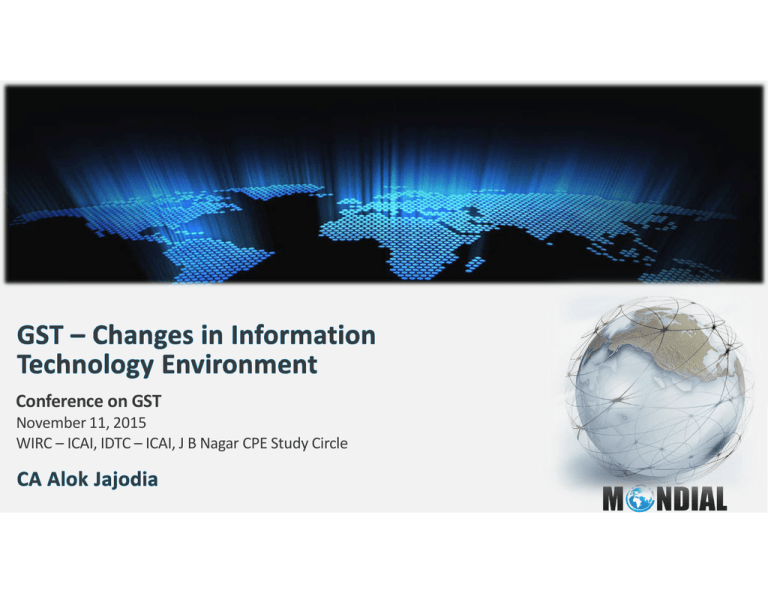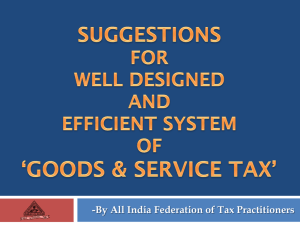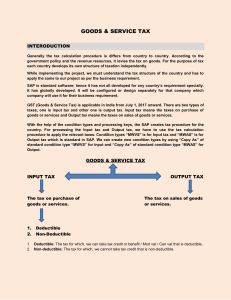Conference on GST November 11, 2015
advertisement

Conference on GST November 11, 2015 WIRC – ICAI, IDTC – ICAI, J B Nagar CPE Study Circle GSTN GST – Technology Impact & Enablers Key Take Aways 1st Discussion Paper Constitution 13th Finance Amendment Bill Commission 2011 Report 2011 2009 Parliament Standing Committee Report Constitution Amendment Bill 2014 Constitution Amendment Bill 2014 Passed in LS Select Committee of RS submitted Report 2013 2014 2015 Approval of Constitution Amendment Bill 2014 by RS Approval by State Legislatures by minimum 15 states Bill to be sent for Presidential assent President to constitute GST Council GST Council to recommend GST legislations Awaited IMPACTS Turnover & Profit Pricing Cash Flow Vendor / Customer contracts IT Systems Supply chain Business Processes Change Management 1st Discussion Paper Constitution 13th Finance Amendment Bill Commission 2011 Report 2011 2009 Parliament Standing Committee Report Constitution Amendment Bill 2014 Constitution Amendment Bill 2014 Passed in LS Select Committee of RS submitted Report 2013 2014 2015 Approval of Constitution Amendment Bill 2014 by RS Approval by State Legislatures by minimum 15 states Bill to be sent for Presidential assent President to constitute GST Council GST Council to recommend GST legislations Awaited IMPACTS Turnover & Profit Pricing Cash Flow Vendor / Customer contracts IT Systems Supply chain Business Processes Change Management MJ1 MJ2 Desirable features of Goods & Service Tax Network (GSTN) Stake-holders *Source: Empowered Group on IT Infrastructure on GST headed by Shri Nandan Nilekani Work-flows Slide 6 MJ1 Mayur Jain, 21/11/2015 MJ2 Mayur Jain, 21/11/2015 The solution architecture, the role of the common GST portal, and its connections with other systems Given the need for a common GST portal, the basic solution architecture is as follows: 1. Taxpayer files through a standardized taxpayer interface. 2. The taxpayer and tax authority systems are connected with a Common GST Portal, operated by GSTN. 3. Policy decisions are captured in GST Business Rules Engine that defines the tax rates, revenue sharing rules, and exceptions for all parties. 4. States and CBEC implement tax administration systems for assessments, audits, and enforcement within their domain. This is desirable but not a precondition since the GSTN can provide support for states that do not have the necessary IT systems in place. *Source: Empowered Group on IT Infrastructure on GST headed by Shri Nandan Nilekani State fund flows directly from taxpayer to states, Centre fund flows directly from taxpayer to centre • Information flows unmodified through common GST portal to states and CBEC • Common GST portal will also integrate with systems of CBDT, MCA,ICES, etc. *Source: Empowered Group on IT Infrastructure on GST headed by Shri Nandan Nilekani • There has been some concern around reconciliation of ITC at invoice-level detail due to the sheer volume of data. However, this scale is no different than what organizations such as NSE, NSDL, RBI, and banks handle on a daily basis. • Experience at states that have implemented this also shows that match quality is low initially, but improves significantly over time. *Source: Empowered Group on IT Infrastructure on GST headed by Shri Nandan Nilekani • As taxpayers start filing invoice level returns, the common GST portal can start analysing the data for tax evasion and fraud. • Common formats for returns and payments, combined with electronic filing and electronic payments, and a standardized PAN-based registration makes the data consistent, and amenable to mining. *Source: Empowered Group on IT Infrastructure on GST headed by Shri Nandan Nilekani Joint Committee Reports on business processes: Registration Refunds Payments Returns Excise VAT CST Service tax others… UPGRADING… GST Excise VAT CST Service tax others… UPGRADING… GST Refunds Joint Committee Reports on business processes: Payments Returns Registration • PAN based registration • Per State registration Different verticals of one business may obtain separate registration • Existing Taxpayers – Transition system for migration • Registration for each premises in a State not required • Addition of place of business under each registration allowed • Transfer of credit to another unit in a different State not allowed • Unified return form for all States/ One Return for CGST, SGST & IGST • All returns to be electronic • Return expected to be Monthly (Quarterly for compounding dealers)/ Annual • All details of sale (invoice wise) to be submitted, purchase details to be populated from sales of counterparty dealers • State specific return as State unit is an independent unit • IGST assessment by State where return is filed • Standardized single challan for CGST, SGST and IGST • Different accounting codes for various types of transactions • Mode of payment of tax can be online or offline (OTC) • Tax to be paid prior to filing GST return • Tax to be paid wherever supply takes place • SGST to go automatically to the State of taxpayer as per registration • Frequency of tax payment as per return • CGST/ SGST/ IGST credit can be utilized for offsetting liability against same heads in that order • CGST/ SGST credit available after offsetting respective liability to offset IGST liability • Credit of CGST cannot be used to offset SGST liability vice-versa • Credit of IGST available after offsetting IGST liability to offset CGST/ SGST liability (in order) • IGST on Imports: as per return (not like customs duty) Gear up Assess Changes and Evaluate Impact Set up Execution and Implementation Transit to Live Go Live on the GST GST 360 Track, Evaluate & Implement post implementation changes



